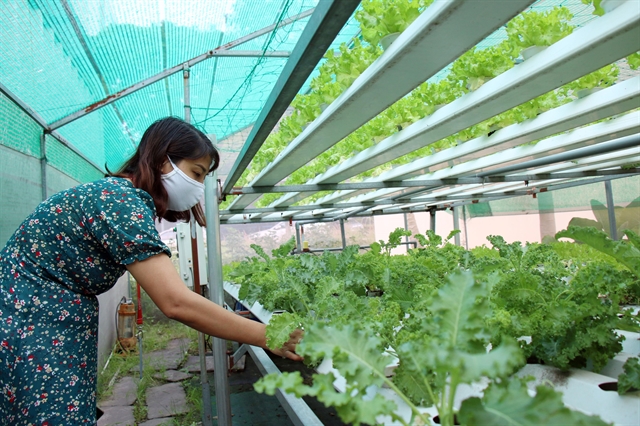 Society
Society


|
| Organic vegetables are planted at the experimental zone of information technology application in agriculture of HCM City-based Quang Trung Software City. — VNA/VNS Photo |
HCM CITY — Establishing a village where farmers can work and live in the urban areas is the dream of those who work at a software company in HCM City.
Quang Trung Software City, which was founded in 2001, is the first and largest software park in Việt Nam. Located in a total area of 43 hectares, it has been assigned to develop the Vietnam software industry and star-tup community.
The ‘Smart Village’ model is the new model of Quang Trung Software City, combining village life and high-tech agricultural production. It has been piloted in a 5,000 square metre area.
It is designed for farmers to live and work at the same place. The cultivation process is organic, chemical-free farming.
The model will take advantage of successful projects of Quang Trung Software City, such as automated hydroponic system, tropical green house, irrigation monitor, mushroom greenhouse, and industrial microwave dryer system for agricultural production activities.
The crops grown are common vegetables and flowers. Currently, between eight and 10 types of vegetables have been planted in the village.
The model is expected to be implemented at the end of this year.
Lâm Nguyễn Hải Long, director of Quang Trung Software City said this was the new trend of applying high technology in agriculture, creating a network of agricultural technologists and creating commercial products.
Smart Village, according to Long, would be an upgraded model helping farmers to easily apply high technology to each product.
It will be a place worth living for people with a technology platform for sustainable development. Waste will be treated and recycled to continue serving agricultural production, he said.
High technology applied in the project includes biotechnology (plant varieties, soil improvement, irrigation water treatment), organic technology (enriching soil nutrients, killing pathogens, increasing plant resistance), nanotechnology (caring and providing nutrients and micronutrients for plants by means of mist spray controlled by digital technology), and cold plasma technology (soil and water treatment and preservation of products after harvest).
IoT technology with sensors will help measure the growth of crops, the production environment, and monitor automatic systems of irrigation, mixing organic nanocomposites as well as detecting and repelling insects.
Digital and blockchain technologies will also be applied for traceability of goods, management of production processes and chain link by value.
Quang Trung Software City director Hải Long said the company started implementing the experimental zone three years ago.
“We came from the countryside and witnessed farmers working hard all year round but gaining low profits, so we came up with the idea to bring information technology into agriculture,” he said.
Many models have been studied and piloted, however, most are not efficient and commercial as farmers found it unaffordable and difficult to apply.
“Software is just software if it is not applicable”, he said.
The model of Smart Village, with 90 per cent of domestic technology, would be a new hope for both experts and farmers.
To serve the goal of building a ‘Smart Village’, the company has built a Research and Development Zone with the help of science and technology experts and enterprises. At least ten enterprises, all Vietnamese, have joined the project.
Trần Anh Tuấn, Chairman of the Board of Directors of Sao Bắc Đẩu Technology Joint Stock Company and one of the founders of the model, said the village would be piloted and assessed before transferring to localities.
In Smart Village, high technology-applied agricultural production and tourism development would be implemented at the same time. The main goal was to increasing income for farmers. Tuấn cited the model of planting flowers in the Netherlands as an example, saying 40 per cent of farmers’ income was from tourism development. — VNS




